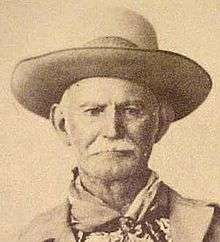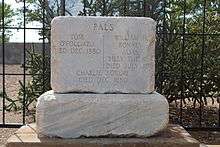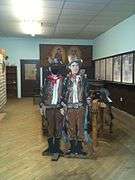Brushy Bill Roberts
| Brushy Bill Roberts | |
|---|---|
 Brushy Bill | |
| Born | c. 1860 |
| Died |
December 27, 1950 (age ~90)[1] Hico, Texas, U.S. |
| Nationality | United States of America |
| Other names |
William H. Bonney (alias Billy the Kid, allegedly) Oliver Partridge Roberts Oliver L. Roberts |
| Occupation | Prospector |
Brushy Bill Roberts (c. 1860 – December 27, 1950; claimed date of birth December 31, 1859) a.k.a. Ollie Partridge William Roberts, Ollie P. Roberts or Ollie L. Roberts, attracted attention by claiming to be the western outlaw William H. Bonney, a.k.a. Billy the Kid. Roberts' claim has been rejected by almost all historians (and even his own niece), but there is circumstantial evidence suggesting his claim may have had some substance. Brushy Bill's story is promoted by the "Billy the Kid Museum" in his hometown of Hico in Hamilton County, Texas.[2][3] His claim was further promoted by the 1990 film Young Guns II, as well as a 2011 episode of Brad Meltzer's Decoded on the History Channel. Robert Stack did a segment on Brushy Bill in early 1990 on the NBC television series Unsolved Mysteries.
In 2014 new information was published, which included military and genealogical records, that supported certain aspects of Brushy Bill's story. A new photographic comparison of a young Brushy Bill with the Billy the Kid ferrotype image was included.[4]
Background
In 1948, a paralegal named William Morrison located an elderly man named Joe Hines, who had requested the lands of his deceased brother. Hines had confessed that he was the outlaw Jesse Evans, who had vanished from public view after getting released from a Texas prison in 1882. Hines told Morrison of his experiences in the Lincoln County War with Billy the Kid, who had been killed by Sheriff Pat Garrett on July 14, 1881. Hines stunned Morrison by claiming that the Kid was still alive and living near Hamilton, Texas under the name Ollie P. Roberts (nicknamed "Brushy Bill").[5][6]
Morrison then began a correspondence with Roberts, who eventually confessed to being the Kid, and who went into fine and intimate detail of his exploits as an outlaw. He filled in many aspects of the life of Billy the Kid and, furthermore, wanted Morrison's help to acquire the full pardon he had been promised by New Mexico Governor Lew Wallace in 1879 but then had been refused. He showed his ability to slip out of handcuffs, and he also reported that Garrett had actually shot and killed another gunslinger named Billy Barlow and had passed his body off as the Kid's, which had allowed the Kid to vanish and escape to Mexico.
Roberts told Morrison that he would agree to tell the "whole truth" in exchange for the full pardon he had been promised by Wallace following the Lincoln County War. His sudden appearance and request for a pardon had a profound effect on Garrett's descendents.
Brushy Bill claimed to have been born William Henry Roberts in Buffalo Gap, Texas, near Abilene, on December 31, 1859.
Roberts' niece, Geneva Pittmon, was able to show that her uncle's (Oliver P. Roberts, not Oliver L.) date of birth had been recorded in the Family Bible. However, the problem with her statement regarding the unknown birth date of Oliver L. Roberts is that Brushy Bill claimed that Oliver P. had been his distant cousin, and after Oliver P. died, he had assumed his deceased cousin's identity. Because Billy the Kid was 21 at the historic time of his death in 1881, if either of the later two birthdates for Roberts are true, then it would be impossible for him to have been the Kid. Brushy Bill had been living under the alias of Ollie L. Roberts, and from the time Geneva Pittmon was a little girl, she was told that Brushy Bill was her uncle Ollie. She had never known the truth of his identity because her father, Thomas U. Roberts, had helped to hide Brushy and keep his identity as Billy the Kid secret.[7]
Brushy Bill Roberts had not been able to convince his half-sister, Martha V. Roberts, that he was indeed Billy the Kid. She had been born September 3, 1873, and she had always said that she knew the difference between a brother and a cousin. She said that Ollie was not her cousin but her brother. Ollie, aka "Brushy Bill", would come to her house in Jacksonville, Texas, wearing his boots and cowboy hat, and he would tell everyone that he had a secret, that he was Billy the Kid, but they had not believed him.
It is worthy of note that if Brushy Bill had been born in 1859, he would have been ninety at the time of his death from a massive heart attack in Hico, Texas. Had he been born in 1879, he would have been only seventy-one at the time of his death.[1] In addition, Roberts had allegedly claimed to be a member of Jesse James' gang, before deciding to come out as the "true" Billy the Kid.[8]
In support of his story, Brushy Bill had every scar that Billy the Kid had sported (and more).[9] Morrison also attempted to track down former Evans Gang member Jim McDaniels, locating him in Round Rock, Texas. McDaniels, along with Severo Gallegos, Martile Able, Jose Montoya, and Bill and Sam Jones, all of whom had known Billy the Kid, signed affidavits claiming to verify that Roberts was in fact Billy the Kid.[10][11][12] The Kid had spoken Spanish fluently and could read and write (his letters to Governor Lew Wallace seeking a pardon still survive), but historians still argue over whether Brushy Bill was even literate. However, when Morrison took Brushy to visit with Severo Gallegos, Brushy spoke with Severo's Mexican neighbor, Josephine Sanchez, in perfect Spanish. Jim Tully signed an affidavit that Brushy could speak Spanish as well as a native. Bob Young, Alton Thorton, W. F. Hafer, Jimmy Ramage, Ablo Norman, Tom Turner, and L. L. Gamble also said Brushy was fluent in Spanish.
On the morning of the 29th, as Morrison and Brushy ate breakfast at a Santa Fe diner, Morrison read in a local newspaper that New Mexico governor, Thomas J. Mabry had publicly announced his meeting with a Billy the Kid claimant. Morrison immediately telephoned Mabry, who apologized for making the announcement, but reassured him that the meeting would still be kept private. A few hours later, Brushy and Morrison arrived at Mabry's mansion. Upon entering the conference room, they were shocked at what they saw. Present in the room were several photographers and reporters, armed policemen, Oscar and Jarvis Garrett (Pat's sons), Cliff McKinney (Kip McKinney's son), Arcadio Brady (William Brady's grandson), and historians William Keleher, E. B. Mann, and Will Robinson. In short, the private meeting had developed into a media circus. Badly frightened, Brushy apparently suffered a mild stroke, and when the questioning began, he failed miserably. However, the men asking the questions seemed to treat the affair as something as a joke, some ridiculed him and refused to ask questions while others primarily asked meaningless questions (i.e. how many girlfriends he had, did he enjoy stealing livestock, etc.). He completely forgot basic information about himself and, when asked a question regarding the past of Billy the Kid, he couldn't remember Pat Garrett's name. Stating he felt ill, he was eventually taken to another room to lie down. Shortly thereafter, Governor Mabry made an announcement that he was not going to pardon Brushy, because he did not believe him to be Billy the Kid. Disappointed, Morrison took Brushy to a local doctor, Stan Lloyd, and when he was well enough, he took him home to Hico.[5]
In Hico, Brushy was reexamined by Dr. W. F. Hafer and told to get as much rest as possible. In the meantime, Morrison was to continue working on his case.
On December 27, 1950, when his wife said she needed to mail a package, Brushy said he would walk it down to the post office. As he walked down the street, Brushy suffered a heart attack. He fell to the ground and died shortly afterwards.
Brushy and his story were largely forgotten until the movie Young Guns II depicted him as the narrator of events surrounding the life and times of Billy The Kid and the Lincoln County War. More books were written on the mystery and researchers began exploring whether Brushy’s claim might have actually been true. The debate has raged to this day including several failed attempts to obtain permission for exhumation and DNA testing.
Numerous books have also been published since 1950 advancing Brushy's claim, the first of which was Alias Billy the Kid written by Morrison and the renowned western historian C.L. Sonnichsen. This book received mixed reviews at the time but did win support from former President Harry S. Truman who wrote to Morrison indicating he believed that Brushy was Billy the Kid and lamenting that he died before being able to go in front of the next governor, where he may have gotten a more favorable result.[13] In October 2014, new information was published in the book Billy the Kid: An Autobiography, which included military and genealogical records that supported certain aspects of Brushy Bill's story. A new photographic comparison of a young Brushy Bill with the Billy the Kid ferrotype image was included as well as a photo of him serving with the Rough Riders just as he had claimed.[14] In April 2015, media personality Bill O'Reilly weighed in on the topic by publishing his book Bill O'Reilly's Legends and Liars: The Real West in which he suggests that the evidence in favor of Brushy Bill Roberts outweighs the accepted version of history citing the original Alias Billy the Kid book by Morrison and Sonnichsen. O'Reilly followed up his book with an episode on the subject during his national television broadcast depicting the events that occurred during the alleged killing of the Kid from Brushy Bill's perspective.
Photograph
In 1989 the Lincoln County Heritage Trust commissioned a computer study by forensic anthropologist Clyde Snow. Scanned photographs of Billy and Roberts, along with those of 150 other people, were fed into a computer utilising a "similarity index" to match 25 facial "landmarks". This resulted in Roberts' photo ranking 42nd (i.e.: 41 other people more closely resembled the tintype than Roberts). Snow indicated that if the two were the same person, then Roberts should have ranked at least 2nd. It was noted that the accuracy of facial comparisons are dependent on the position of the face in the photographs being the same.[15]
In 1990, a study utilizing photo comparison equipment in the Advanced Graphic Laboratory in the University of Texas was conducted by image-experts Scott Acton and Alan Bovik. The study corrected for the facial positioning and used the same face recognition techniques used by the FBI, CIA and Interpol which are claimed to provide a "significant level of statistical validity". Photographs of Brushy Bill Roberts at age fourteen seemed to resemble the well known Dedrick-Upham tintype of Billy The Kid. A photograph of Brushy Bill at age 90 was a 93% match. Both Acton and Bovik concluded that their result proved "beyond the shadow of a doubt" that Billy the Kid and Brushy Bill were the same person. In 1996 the results of the study were presented to Andre McNiel, chancery judge of the 12th judicial district, and a prominent Arkansas attorney Helen Grinder, who stated that based on the study and other evidence the case for Roberts being Billy the Kid was "strong and substantial".[16]
DNA

In 2003 Lincoln County Sheriff Tom Sullivan, Capitan, New Mexico Mayor Steve Sederwall, and De Baca County, New Mexico Sheriff Gary Graves began a campaign to exhume the remains of Billy the Kid and his mother, Catherine Antrim, to prove it was in fact Billy the Kid buried in Fort Sumner through DNA. The initiative hit snags from the beginning. First, there is no confirmation as to where the remains are located. Second were the legalities, with both pro-Brushy Bill Roberts and anti-Brushy Bill Roberts experts protesting the exhumation. The exhumation of both sets of remains was blocked in court in September 2004.
- Problems with DNA testing
- The Fort Sumner Cemetery where Billy the Kid was said to have been buried was washed out by the Great Pecos River Flood in 1904. The damage was so great that exposed remains had to be reburied with most being unidentified. Billy's headstone had been washed away and his grave remained unmarked for 28 years. Although a headstone was erected in 1932 it is unknown where the original grave was.
- The Silver City cemetery where Catherine Antrim was buried was sold in 1882 with the new owner required to relocate the graves outside the city limits. There is no record to indicate whether the bodies were moved or just the headstones. It is possible that other people had been buried in the same grave. It is possible that she had been originally buried in an unmarked grave with the headstone placed by guesswork later.
- Considering the length of time since burial it is likely any remains have decomposed completely and there is a negligible chance of positively identifying remains if any are found.
- Roberts claimed Catherine Antrim was not his mother but an aunt related by marriage so a DNA test would be meaningless in any scenario other than Catherine and Billy's remains both being identified, tested and shown to be mother and son.
Hico, Texas
At the time of his death, Brushy Bill lived on West 2nd Street in Hico. He was buried in the county seat of Hamilton, twenty miles south of Hico. Despite the discrepancies noted above, the Hico Chamber of Commerce has capitalized on his claim by opening the "Billy the Kid Museum" in the historic Western section of Hico.[2][3] In the downtown is a marker devoted to Brushy Bill: "Ollie L. 'Brushy Bill' Roberts, alias Billy the Kid, died in Hico, Texas, December 27, 1950. He spent the last days of his life trying to prove to the world his true identity and obtain the pardon promised him by the governor of the state of New Mexico (Lew Wallace). We believe his story and pray to God for the forgiveness he solemnly asked for [sic]."[17]
| Billy the Kid in Hico | ||||||
|---|---|---|---|---|---|---|
|
See also
- American Folklore
- The Authentic Life of Billy, the Kid
- Cowboy
- List of American Old West outlaws
- List of Western lawmen
- Mention in Billy the Kid article
References
- 1 2 The Real Billy the Kid?, page 97
- 1 2 Texas Department of Transportation, Texas State Travel Guide, 2008, pp. 200-201
- 1 2 L. B. Kesner (24 July 2006). "Hico Travel Guide – Hico Things to Do". Virtual Tourist. Retrieved 2011-01-16.
- ↑ Billy the Kid: An Autobiography by Daniel A. Edwards, Creative Texts Publishers
- 1 2 Westcoast Sign Guy (31 May 2006). "Brushy Bill Roberts and Billy the Kid — The Complete Facts". TheSignSyndicate.com. Archived from the original on 2009-10-03.
- ↑ "The Real Kid". Soft-Parade.com.
- ↑ The Real Billy the Kid?, page 33
- ↑ Fowler, Gene (2008). Mavericks: A Gallery of Texas Characters. Austin, TX: University of Texas Press. p. 45.
- ↑ The Real Billy the Kid?, page 8
- ↑ Westcoast Sign Guy (31 May 2006). "Brushy Bill Roberts and Billy the Kid---The Complete Facts". TheSignSyndicate.com. Archived from the original on 2009-10-03.
- ↑ Anonymous (18 May 2015). "Brushy Bill Roberts and Billy the Kid---The Complete Facts". Angelfire.com.
- ↑ "Alias Billy the Kid", C. L. Sonnichsen & William V. Morrison
- ↑ Sonnichsen, C.L.; Morrison, William V. (1955). Alias Billy the Kid. University of New Mexico Press. p. Back cover. ISBN 1507590792. Retrieved September 22, 2015.
- ↑ Daniel A. Edwards. Billy the Kid: An Autobiography, Creative Texts Publishers. <Oct. 31, 2014, 252 pages, ISBN 1508714509>
- ↑ Joe Nickell Camera Clues: A Handbook for Photographic Investigation Kentucky University Press 2005 Pg 89-90 ISBN 0-8131-9124-6
- ↑ Jameson, W. C. (2005). Billy the Kid: beyond the grave. Pg 103-106: Taylor Trade Publications. ISBN 1-58979-148-7. Retrieved 2013-04-12.
- ↑ Roberts historical marker, Hico, Texas
